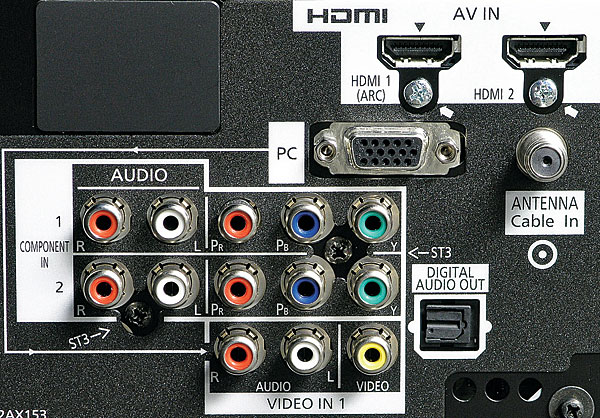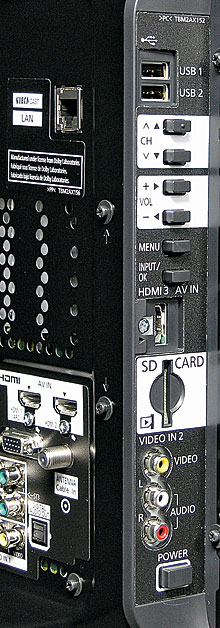I believe this is either a grave typo (GT25 instead of GT30), or a reprint. The GT25 is a 2010 and the new GT30 is 2011 - and the review date is 3/11/2011. If this indeed an review of a 2010 model television - I would personally question the validity of reviewing a TV that is over a year old in release, as I would much prefer to read a review of the newly released 2011 Panasonic Viera models - especially the GT30, ST30, and VT30's. I love the reviews and articles here's at HT, but reviewing a 2010 TV a year late seems a bit....off?
Panasonic Viera TC-P50GT25 3D Plasma HDTV Page 2

You can enjoy your still photos, full-motion images, and music through a connection to your home network or from a USB device or SD card.
 Viera Link, Panasonic’s version of the industry-wide HDMI Consumer Electronics Control (CEC) standard, offers simultaneous control of all Panasonic components equipped with Panasonic’s HDAVI Control via the set’s remote. The TCP50GT25 is also ENERGY STAR qualified.
Viera Link, Panasonic’s version of the industry-wide HDMI Consumer Electronics Control (CEC) standard, offers simultaneous control of all Panasonic components equipped with Panasonic’s HDAVI Control via the set’s remote. The TCP50GT25 is also ENERGY STAR qualified.
The specialized 3D controls are similar to those on most of the 3D sets we’ve seen and tested. While the set should automatically recognize and switch to the appropriate 3D mode, you can set a 3D format control manually if necessary.
Flat Right
The Panasonic appeared to be a bit more prone to temporary image retention than is average for a plasma, even with the set’s pixel orbiter (an anti-burn-in feature) turned on. During my testing, the issue only cropped up when menus remained on the screen for an extended period of time—such as during a calibration, and particularly in the extra-bright 3D mode. While
3D may not look particularly bright through 3D glasses, it’s definitely very bright from the screen’s viewpoint. But the image-retention shadows faded a few minutes after I returned to normal program material.
As with all plasmas, I recommend the usual sensible but not paranoid cautions—avoid extended display of still images or all-day marathons of material that puts black bars on the screen, such as 2.35:1 or 4:3 movies. This is particularly important during the first 200 hours or so of use, when the phosphors are new (the retention observed above was with about 150 hours on the set).
The Panasonic offers all the strengths of plasma, further enhanced by the ultra-fast phosphors Panasonic uses for its 3D designs. The screen’s reflectivity is about average for a modern flat panel, but when there’s no image on the screen, or when the set is off, it looks grayer with some types of room lighting than many competing sets. You’ll definitely see the TC-P50GT25 at its best, including its premier black-level capabilities, if you avoid room lighting that reflects directly off the screen. That’s true of any set, but particularly so here.
The Panasonic’s only problem with any of our standard video processing tests (see the Video Test Bench chart) was some visible moiré on the 2:2 playback test—a common failure on many sets. Although the Panasonic’s video scaling (upconversion from 480p to 1080p) just edged into the bottom end of the Good range, it’s unlikely to cause visible problems on real-world program material.
Before calibration, the 2D
THX mode looked respectable, but it wasn’t particularly accurate. After calibration, the picture was stunning. I recognized the set’s full potential right off the bat, as my first choice of material was the recent Criterion Blu-ray release of the 1947 film Black Narcissus. Many classic movie fans swoon over this film. I’m in the minority; I find parts of it, and definitely the last 30 minutes, Mystery Science Theater 3000 worthy. But the 4:3 photography is gorgeous. The creative use of light and shadow, together with the use of the Technicolor process (still fairly rare when the film was made) were amazing to see on the Panasonic. The set’s detail, together with the clarity of the HD transfer, clearly revealed that the film was shot entirely on soundstages, with matte paintings standing in for the story’s Himalayan location. Some shots looked a little soft, and none were as crisp as many modern films, but that’s to be expected in a 64-year-old movie.
- Log in or register to post comments


This year Panasonic offers some new models: http://bit.ly/3dpnsonic




















































